The Cosumnes Community Service District (CCSD) is the governing body for all the Elk Grove parks and recreation as well as the Elk Grove/Galt Fire Department. It is a massive responsibility, but they have done a tremendously wonderful job and we have one of the most beautiful park systems in the state.
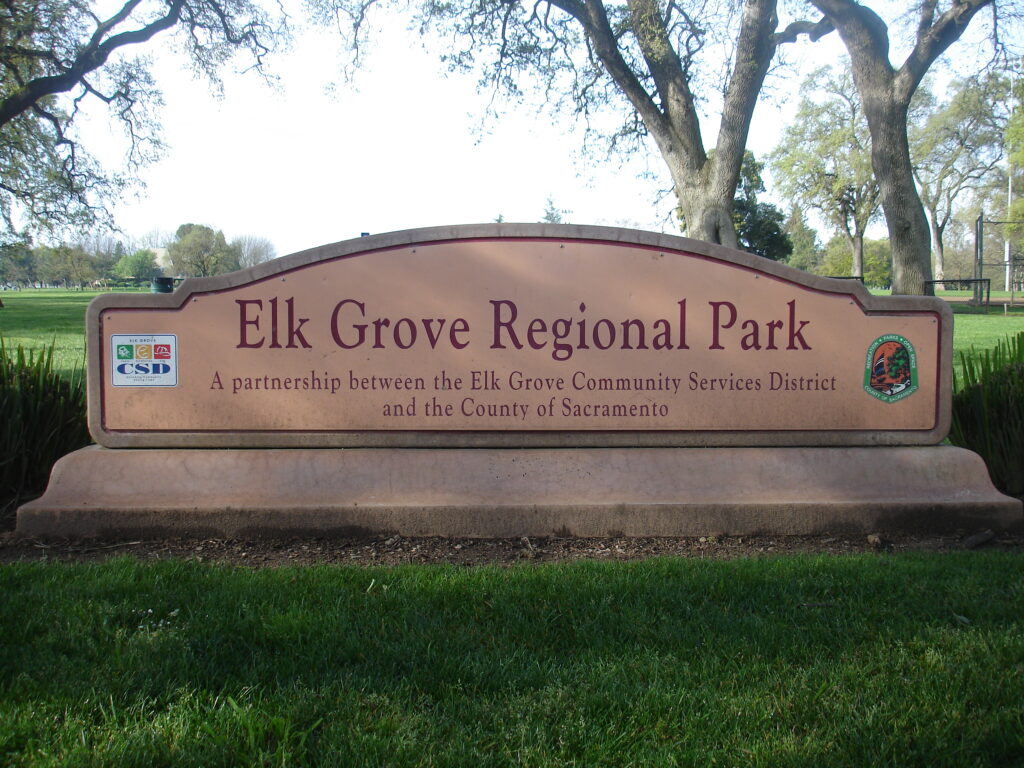
Those beautiful oak trees in the Park were responsible, in part, for our name Elk Grove and some have been there for hundreds of years when our Miwok people called this their home.
It all started with the preservation of the Elk Grove Park by a young girl and here is the story of the first park in our area.
In the 1800’s families from all over Northern California came for picnics in the grove of trees now called the Elk Grove Reginal Park. In the very early years Families would travel the few hours by horse and buggy from Sacramento to meet their friends in the park for a social gathering and picnic. The Grange organization was famous for holding huge picnics. It was so popular that in 1868 when the railroad came through Elk Grove, there was even talk about having a line run to the park for the many people that were drawn there for the picnics.
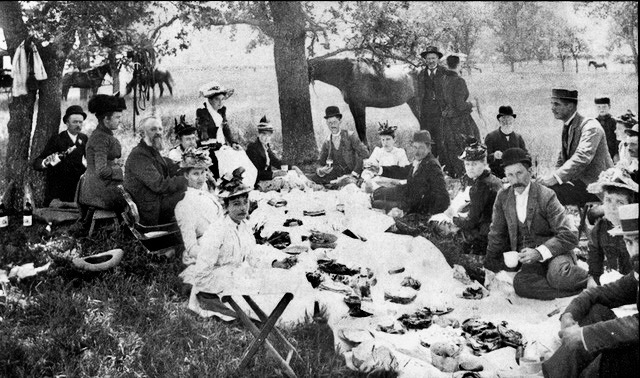
“A great entertainment in the Elk Grove area was the famous Grange Picnic that was held in a grove of trees that make up our present-day Elk Grove Park. Picnics were popular ways for people to get together as they are still today. There were grand picnics that attracted large numbers of people were often the social events of the season.
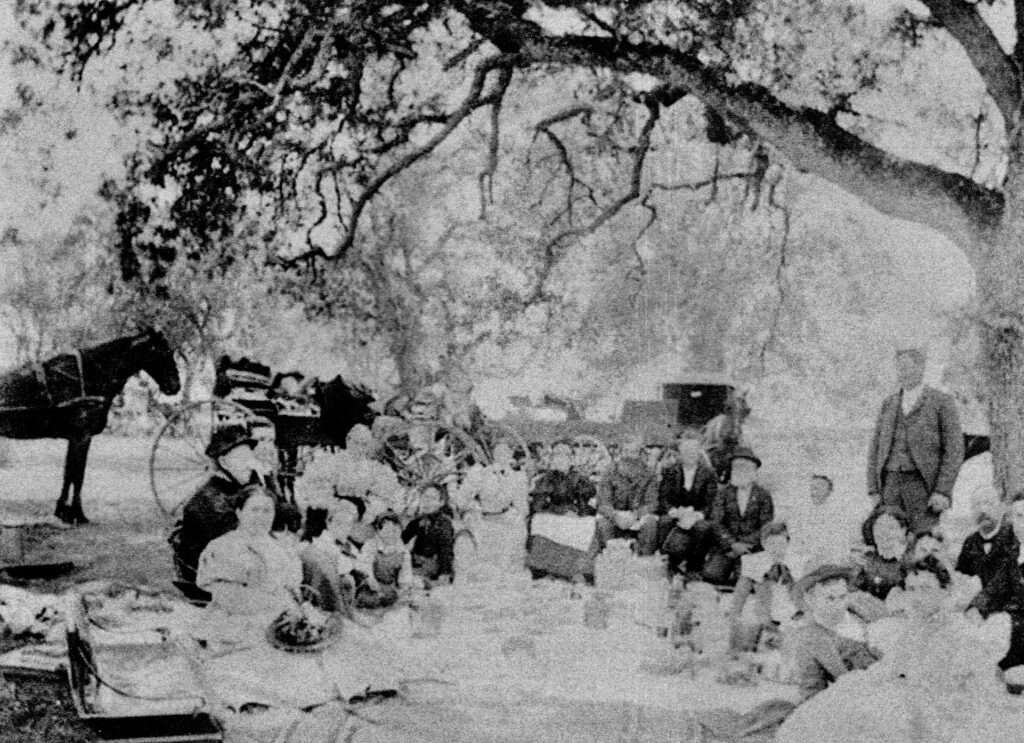
We can thank a young girl named Jennie McConnell, for what she did when she saw that the trees were being cut down by the owner of the property in 1902. She was riding her horse past the trees when she noticed that they were being cut down…
Mr. Markofer’s owned the land in 1902, perhaps the most noted occurrence in the park’s history took place when Jennie McConnell – daughter of Thomas McConnell, who served as the first Grange Master of Elk Grove Grange #86, showed immediate interest in the then-threatened oak trees on the parkland.
“One day as I was riding past (the park), a tree fell into my path,” Jennie said. “The owner of the property had cut it down.” Noticing that about 50 acres had been cut down, she became greatly concerned about the demise of the trees on the property.
Consequently, she asked her father how they could be saved, and he advised her to form a corporation that would sell shares to purchase the property where the grove of trees was located.
Jennie approached, Mr. Markofer, who was sympathetic to her concern and desire to save the trees. He in turn gave her a year’s option on the property for a sum of $1.
A corporation, called The Elk Grove Park Association, was formed on April 27, 1903 with Thomas McConnell, as president and a board consisting of George Foulks, Fred Gage, Jane McConnel and Ernest Springstead.
Shares were sold to community members and Elk Grove Park became a reality owned by the people. The $5 shares brought in enough money to purchase the 35 acres for $4,446 and develop the park. The corporation was named the Elk Grove Park Association. Of the first stock sold, Thomas McConnell held 20 shares; Jennie McConnell, 20 shares; E.W. Springstead 10 shares; George W. Foulks, 10 shares and Cora Gage one share.
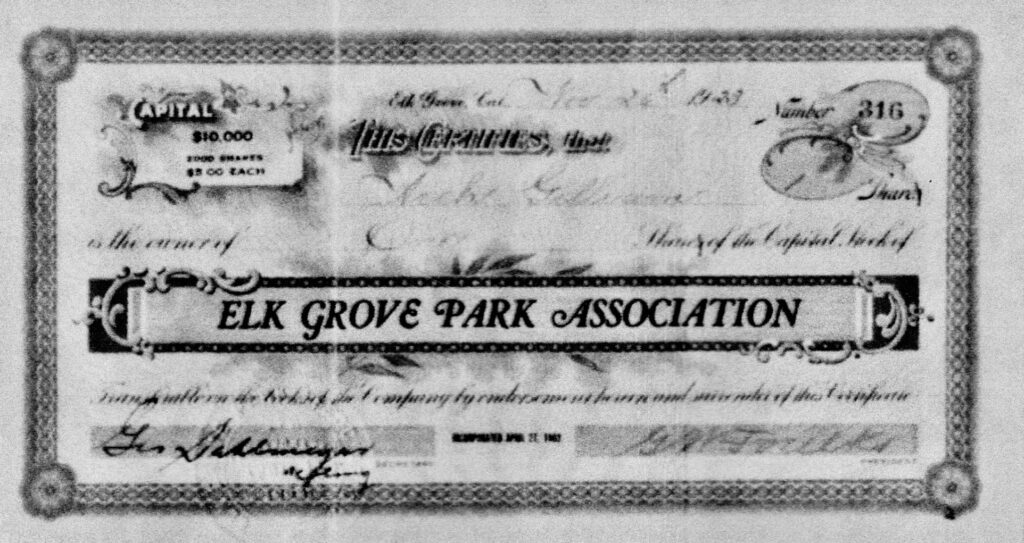
According to records, the first group to rent the park for a picnic was the Elk Grove Grange for its annual picnic, May 7, 1904. The Grange paid $100 for the use of the park.
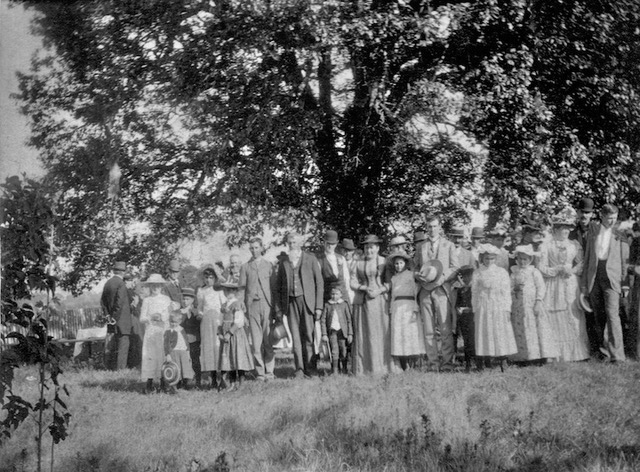
The directors then had an open-air dance platform and band stand built, which was 100 feet long and 70 feet wide. The low bid was $1,419.50 for the construction, entered by E. E. Barry, who received the contract.
The first baseball diamond was developed in the park during April 1904, which has since been converted to a night lighted softball field.
Also, in 1904, the directors agreed to install a horse trough for the tidy sum of $12. The first light on the dance floor were six gas lights with reflectors.
In 1905, the Boyd Brothers were hired to erect arches over the east and west entrances to the park at a cost not to exceed $40 for both.
At the July 5, 1905 meeting, the directors voted to pay Cora Gage $25 per year for serving a secretary.
At the July 10, 1906 meeting, the Directors voted to let the local Grange have the park at no charge, as that group planned to donate the proceeds from their annual picnic to the disaster relief of people of the San Francisco earthquake and fire.
In 1906, Mr Oppenheim agreed to furnish Elk Grove Park with electric lights for five years at no charge, if the directors would grant him a right of way through the park. His offer was accepted.
In 1924 it became the first rural park district in the state.
In 1935, the California Legislature enacted a law to allow park districts to operate on tax money. Community members organized to form a park district. In 1936, the Elk Grove Park and Recreation District was the first district in California to function on tax money as a rural park district.
A pool was added as WPA (Works Progress Administration) project, one of President Delano Roosevelt’s attempts to get people working during the Great Depression. Two years later, the softball association began, and lights were installed on the field for night playing.
In 1958 there were many new facilities added to the Elk Grove Park including tables and open fireplaces for picnic groups, horseshoe courts, kiddie rides, two baseball diamonds, a swimming pool, a large dance pavilion with a kitchen, and a Boy Scout building with a modern restroom. Two full time groundskeepers were employed along with extra help in the summer months and three lifeguards at the swimming pool.
Emil Wiemeyer was hired by the Directors as grounds keeper, but later resigned and the job was taken over by Lester Horst until 1948 when Paul Tessen became grounds keeper.
The Sacramento County took over the operation and maintenance of the park in 1960 and renamed it the Elk Grove Regional Park. An additional 94 acres were purchased at $2000/acre. These features were added: the pavilion, softball complex, group picnic areas, and the horse arena. The pool was renovated and a 7.5-acre lake with an island was created.
Other changes were made in 1976. The dance hall next to the swimming pool was torn down, and the Rhoads School was moved to the site from Sloughhouse Road. The school was set up as a living history program and that is how it is still used today for hundreds of students. The project was the beginning of the Elk Grove Historical Society. The members set out to reconstruct the Elk Grove Stage Stop building that had been torn down when Highway 99 was created from Stockton Road. The reconstructed stage stop now serves as the home base for the Elk Grove Historical Society, and there are new projects such as the Elk Grove’s long-ago jail, a blacksmith shop, and the original Foulks Ranch House.
In 1985, the park district and the fire district was combined to from the Elk Grove Parks and Recreation District, and later became the Elk Grove Community Services District.
A year later in 1986 the Sacramento County and the Elk Grove Community Service District, now known as the Cosumnes community Service District (CCSD) entered into a 30-year lease. The county would maintain 87 acres of the park and the CSD would maintain 40-acres. In 2003, Sacramento County entered an agreement with the CSD for all operations and maintenance of Elk Grove’s Regional Park’s 127 acres.
That’s as it stands today.
The previous information was compiled by, written by, and taken from several articles by local Elk Grove Historian Elizabeth Pinkerton. We are indebted to her in many ways, over many years for telling the Elk Grove story.